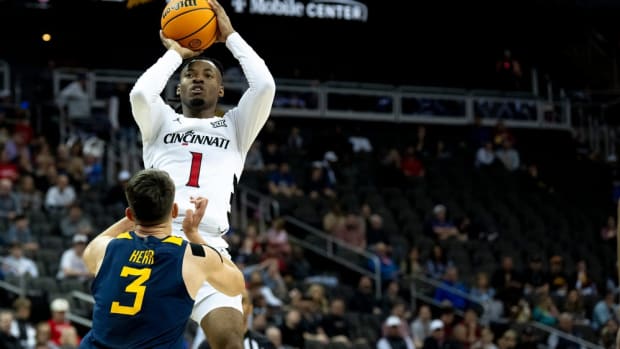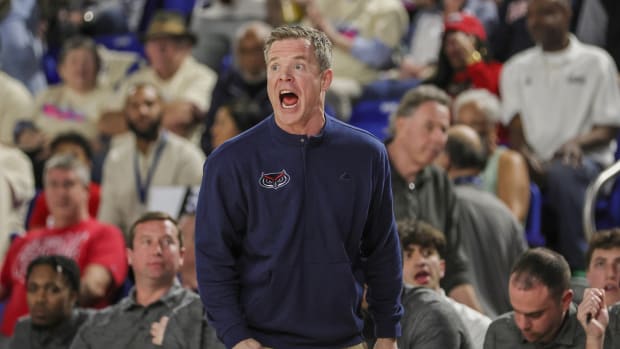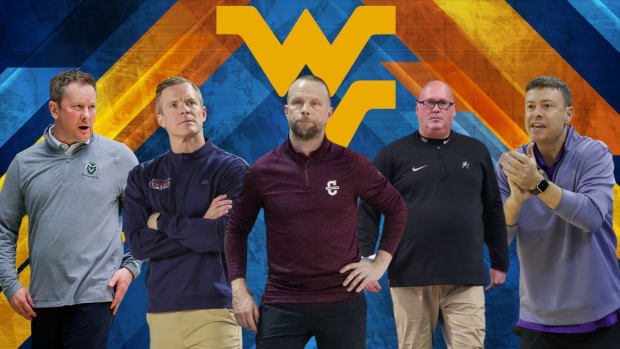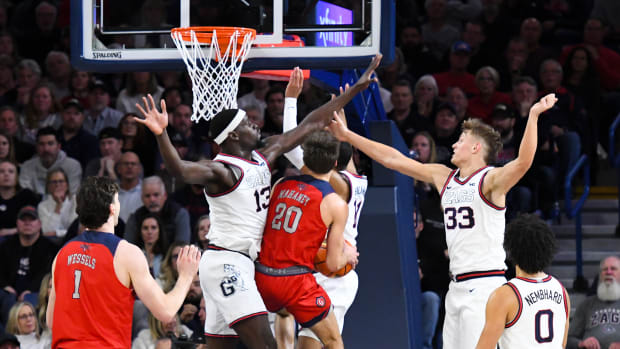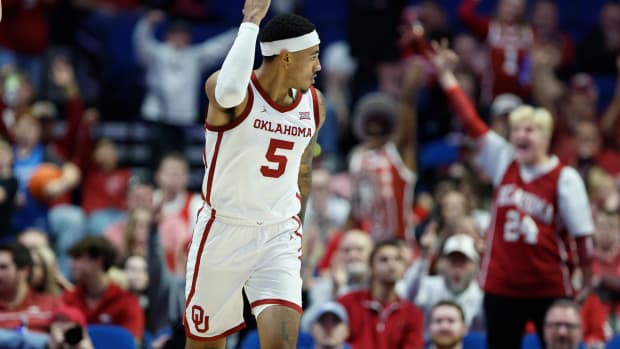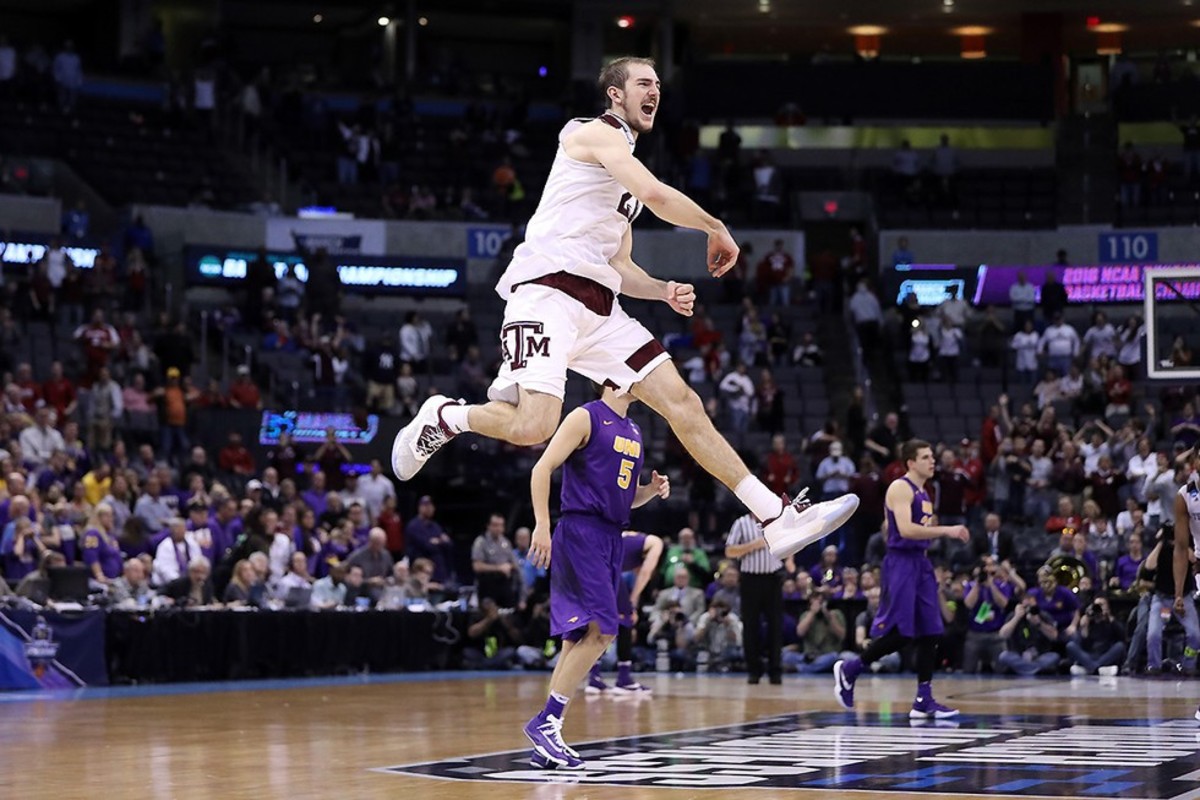
Hoop Thoughts: Reviewing the NCAA tournament's opening weekend & previewing the Sweet 16
[video: 13724937]
With 1 minute and 11 seconds to play in its West Regional second-round game in Oklahoma City, Texas A&M senior guard Alex Caruso drove to the right wing, pulled up from 12 feet, launched a jumper toward the goal ... and missed. This proved to be a most unlucky break for Northern Iowa, for it led to a stunning unraveling that concluded with the most dramatic comeback in the history of college basketball.
How could an opponent's missed shot be deemed unlucky? Allow me to explain.
When Caruso took his shot, Northern Iowa senior guard Matt Bohannon, who was standing on the opposite wing, turned toward the goal and positioned himself for a rebound. He didn't get it—the ball ended up in the hands of his teammate, junior guard Jeremy Morgan—but as he landed, Bohannon's left shin collided directly into the right shin of Texas A&M sophomore forward Tonny Trocha-Morelos. When the play ended, Bohannon sat on the floor underneath the basket and did not move. It appeared for a moment like he was resting, but when he tried to stand up and walk, it was obvious he was in great pain.
Mike Gminski, who was calling the game for truTV, immediately recognized the impact an injury to Bohannon could have. "This is big," Gminski said, "because he's the guy who [UNI coach] Ben Jacobson relies on to take the ball in on out-of-bound plays, especially in the last minute of the game."
Bohannon never returned. If he hadn't gotten hurt—if Caruso hadn't missed that shot—then maybe Bohannon would have made the one or two plays that prevented Northern Iowa from committing the biggest last-minute gag in the history of the sport. Those are the breaks, alas, and in a game like this, in a tournament like this, there are more of those, for better and worse, than we could possibly count.
Yes, there were plenty of factors that went into the Panthers' historic collapse. Northern Iowa made a series of boneheaded mistakes, and Texas A&M made more than its fair share of clutch plays. But we should never underestimate the role that luck plays in all of this. Consider:
• With 38 seconds to play and the Panthers leading 69–57, Caruso missed a turnaround three-pointer. Northern Iowa sophomore forward Klint Carlson was in great position to get the rebound, but the ball hit the back iron and came off softly, allowing it to land in the hands of Texas A&M freshman guard Admon Gilder, who had slid around a poorly attempted box-out by UNI sophomore guard Wyatt Lohaus. Gilder converted the putback to make it 69–59 with 34 seconds to play. If that ball bounces off another foot or two, Carlson would have grabbed it, and the game would have probably been over. Unlucky.
• With 25.8 seconds on the clock and Northern Iowa still leading by eight, Lohaus inbounded the ball to senior forward Paul Jesperson, who then got pinned against the baseline by Trocha-Morelos. As Jesperson fell out of bounds, he tried to throw the ball against Trocha-Morelos's body. Players attempt this move frequently, and it is not all that difficult. The vast majority of the time, he hits the opponent with the ball and his team retains possession. In this case, however, Jesperson completely missed his man, and the ball bounced perfectly to Aggies forward Jalen Jones, who dunked it. Unlucky.
• On the next inbounds, Lohaus tried to throw it to Morgan in the right corner. Gilder was playing aggressive defense along with the rest of the Aggies and was blanketing Morgan. Gilder reached for the ball, but he couldn't quite get to it, so it went straight out of bounds. If Gilder's fingertip had glanced the ball, then UNI would have gotten the next possession, and maybe the game would have been over. Unlucky.
• Inbounding the ball from the baseline on the next play, Caruso fired a pass to senior forward Danuel House. Until six seconds before, House, the Aggies' leading scorer, had not made a field goal in nine attempts. On the season, he has made just 31.1% from three-point range. The odds were very much in Northern Iowa's favor that he would miss. Instead, he swished it, cutting the Panthers' lead to 69–66 with 19.6 seconds to play. Unlucky.
• After Jesperson hit two free throws to put UNI back up by five, the Aggies inbounded the ball to Caruso, who drove the length of the floor and laid the ball in. Jesperson was standing under the rim and backpedaled as Caruso scored. True, Jesperson probably shouldn't have been anywhere close to Caruso on the play, but replays showed Jesperson made no contact. Still, referee Jamie Luckie, who is one of the best in the business, whistled Jesperson for the foul. It was a bad call, plain and simple. Caruso converted the three-point play to make it 71–69 with 11.8 seconds to play. Unlucky.
• Next inbounds, déjà vu all over again, this time with UNI senior guard Wes Washpun getting trapped against the baseline by two Aggies. After making the same mistake of waiting to get fouled instead of passing the ball to an open teammate, Washpun tried the same basic maneuver Jesperson had attempted 23 seconds before. Just like Jesperson, Washpun completely misses his target. The ball bounced right into the hands of Gilder, who sank the game-tying layup with 2.8 seconds to play. Unlucky.
Needless to say, this luck thing goes both ways. On that final sequence, Morgan tried to signal for a time out that UNI didn't have, but Luckie was looking at Washpun and didn't see it. If he had, then Morgan would have been assessed with a technical foul and the game might not have even gotten to overtime.
Then again, maybe that was another unlucky break for UNI, because maybe if a Texas A&M player had gone to the foul line facing that kind of pressure, he would have missed one of the free throws, and the Aggies wouldn't have scored on the ensuing possession, and Northern Iowa would have escaped with the close win. We'll never know.
On the other hand, a huge reason Northern Iowa was playing in this game in the first place was because Jesperson had hit one of the luckiest shots in tournament history two days before, banking in a halfcourt heave at the buzzer that gave UNI a win over Texas in the first round. And a huge reason UNI was playing in that game was because Washpun got a crazy lucky bounce at the buzzer in the final of the Missouri Valley Conference tournament, which gave the Panthers a two-point victory over Evansville and a spot in the NCAA tournament they would not have earned via an at-large bid. And of course, the game before that, Northern Iowa was very fortunate to beat Wichita State in overtime in the semifinal. We can follow this trail for as long as we want, and we'll never count all the strange bounces and fortuitous whistles that decide who moves on this time of year and who goes home.
None of this is to excuse the Panthers' many mistakes down the stretch, or to dismiss the inspired efforts of Texas A&M to pull off the epic comeback. But we should never overlook the importance of luck. I've often quoted a high school basketball coach I got to know while working at the New Haven Register a long time ago. His name is Gary Palladino, and he worked at Notre Dame High in West Haven, Conn. Gary liked to say that basketball is 70% talent, 20% coaching, and 10% luck. If anything, that might be understating the role of luck, especially in the crazy crucible of the NCAA tournament.
So while we can explain all that is happening and analyze why, we must do so with a humble spirit. Analysis only takes us so far. Luck is a big part of the beauty of sports—the beauty of life! During a single, unforgettable fortnight, Northern Iowa experienced extreme luck, much of it good, much of it bad. In doing so, the Panthers gave us a thrilling ride.
Oh, and let's not forget all those Texas A&M fans in Oklahoma City who headed for the parking lot when their team fell behind by 12 with under a minute to play. Now that issome really bad luck.
Here are some quick Hoop Thoughts on the four regions. I can't imagine the next two rounds will be as exciting as the last two, but one can always hope to get lucky:
Grant Halverson/Getty
East
Looking back: I'm struck by the similarity of the journeys taken by Indiana and North Carolina this season. Both came into the season as gifted offensive teams, but both needed to add defensive grit in order to fulfill their potential. Each underwent a galvanizing event to make this happen. In Indiana's case, the injury to sophomore guard James Blackmon Jr. in early January removed a potent scorer from the lineup, but it also elevated an elite defender, freshman forward OG Anunoby, further into the rotation. It also enabled senior guard Yogi Ferrell to have the ball in his hands that much more.
North Carolina, meanwhile, benefited greatly from that dispiriting 74–73 loss at home to Duke on Feb. 17. The Tar Heels had piled up a lot of wins over the bottom teams in the ACC to that point, and the loss reminded them of the mental fortitude that is required in being a championship team. When the Tar Heels are locked in defensively, they are almost impossible to beat.
Oh, and wasn't Indiana coach Tom Crean supposed to be on the hot seat or fired because of the way he paces the sideline and hitches his pants? It was so long ago, I forget.
The other two teams who will be in Philadelphia certainly benefited from luck last week. Notre Dame edged Stephen F. Austin on a tip-in bucket by reserve freshman guard Rex Pflueger. It was his only field goal of the tournament, naturally. And of course, Wisconsin got by Xavier on a buzzer-beating three from deep in the corner by junior guard Bronson Koenig. Even Wisconsin fans didn't believe their team was going to be in the NCAA tournament in mid-January. It is indeed amazing the way Greg Gard has held this group together.
Looking ahead: While I remain concerned about Marcus Paige's shooting (he was 7 for 21 from the field in the Tar Heels' two wins in Raleigh), I still love his leadership and character, and he has shown a knack for making timely buckets. Besides, the team's point guard, sophomore Joel Berry II, has been terrific the second half of the season. Indiana has the better perimeter, but the reason the Hoosiers were able to beat Kentucky was because the Wildcats' frontline was a no-show (which was the case for UK pretty much all season). Indiana has a very good frontcourt player in Thomas Bryant, but he is a freshman who tends to get in foul trouble, so he will be no match for the Tar Heels' deep, veteran front line.
Notre Dame-Wisconsin is basically a coin flip, but if I were a Badgers fan, I'd be concerned about the way Nigel Hayes has been playing. In his last three games, Hayes is 7 for 42 from the field and 0 for 17 from three. A team can only be so lucky for so long with its best player in that kind of a slump.
Grant Halverson/Getty
Midwest
Looking back: My favorite coaching adjustment of last week week came during the second half of Virginia's second-round game against Butler. Cavaliers senior guard Malcolm Brogdon had done a great defensive job (as usual) shutting down Kelan Martin, the Bulldogs' sophomore guard and leading scorer. Problem was, 6'7" junior forward Andrew Chrabascz was singlehandedly keeping his team in the game. So Virginia coach Tony Bennett switched Brogdon on Chrabascz. Brogdon is big for his position (he's listed at 6'5", 215 pounds) but was still giving up a couple inches to Chrabascz in the post. And yet, he essentially made his man disappear (as usual), enabling the Cavs to pull away for a comfortable win.
You have to be impressed with the remarkable jobs that Steve Prohm and Mark Few have done at Iowa State and Gonzaga, respectively. Prohm had the difficult challenge of following an enormously popular coach in Fred Hoiberg (now the head coach of the NBA's Bulls), and he locked horns with the team's best interior defender, senior Jameel McKay. Yet, he still managed to get his team into the Sweet 16. Yes, the Cyclones caught a break in drawing a comfortable matchup against Iona (a team that, like Iowa State, likes to run and score a lot more than it likes to play defense) and then getting Little Rock in the second round. But let's not forget that Hoiberg's last game as coach came in a first-round upset loss to UAB. There are no easy wins in March, and Prohm can breathe a sigh of relief that he is officially playing with house money.
Gonzaga, meanwhile, has made enormous progress over the second half of the season—particularly in the backcourt. What's most impressive about what the Zags accomplished in Denver is that they did it against two teams with completely different personnel and styles. They beat a young, athletic Seton Hall squad, and then they dominated a Utah team that has one of the toughest centers in the country in sophomore Jakob Poeltl. Gonzaga sophomore center Damontis Sabonis totally bottled up Poeltl in that game. He is the best center remaining in the tournament.
Syracuse got the last laugh over those who argued the Orange shouldn't have been in the tournament at all. The team caught a big break in getting to play Middle Tennessee in the second round instead of Michigan State. The Blue Raiders were able to carve up the Spartans' man-to-man defense by putting bigger defenders like Matt Costello into ball screen situations and then drilling open shots. If Tom Izzo had a zone defense he trusted, he would have gone to it. But that kind of offense doesn't work nearly as well against a zone, especially a zone as good as Syracuse's. It's impossible to simulate what it is like to go up against that defense for 40 minutes, which is why Jim Boeheim's teams are so tough to beat in the NCAA tournament.
Looking ahead: Iowa State is as hard to guard as any team in the country, but Virginia is arguably the best defensive team in the country. Can you imagine Brogdon guarding Georges Niang? I sure can—and I can't wait to watch it.
It won't be easy for Gonzaga to solve Syracuse's zone either, but this Orange team does not defend the post nearly as well as Boeheim's teams have in the past. That should mean a good game from Sabonis. But even if Syracuse gets by Gonzaga in that game, it will not have the unfamiliarity advantage if it faces Virginia in the regional final. They play in the same league, so the Virginia coaches and players have gone up against the zone many times.
Kevin C. Cox/Getty
South
Looking back: No team appeared more dominant last week than Kansas, which made mincemeat of a surging, quick, tough UConn squad in the second round. The Jayhawks may not have any surefire NBA guys on their roster, but they play with toughness, guile and cohesion, and they can score from any position and win by playing any style. In past years, a team like this might get out-talented in the end, but in a season like this one, Kansas still feels very much like the team to beat.
Senior guard Jake Layman shot well in Maryland's first-round win over South Dakota State, and even though sophomore guard Melo Trimble is still having a hard time making jump shots, he did a great job getting to the foul line in the second-round win over Hawaii. The Terps beat a pretty good team in that one despite shooting 1 for 18 from three-point range. That tells me a lot about this team's toughness.
But the biggest takeaway for me watching Maryland last week is the distinctive leadership role that Rasheed Sulaimon has taken on. Remember, not only is he a transfer, but he also didn't arrive on campus until very late in the summer because he was finishing up his coursework at Duke. Sulaimon has his flaws as a player (read: pounds the ball too much), but he loves the big moment in a way that few other players do. I believe this team gets a lot of its personality from him, and that is a good thing.
If the tournament is all about matchups, then Iowa drew a very bad one in Villanova. I've been saying for some time that this is the best defensive team Jay Wright has had, maybe second only to the 2009 squad that made the Final Four. Plus, Villanova has been on fire from three-point range of late. The Wildcats' worst tendency is to jack up too many threes even though they are not proficient at it, but when those shots are falling, they are next level.
Looking ahead: The four teams that will gather in Louisville have far more similarities than differences. They have veteran, tough guards who love to defend. They all have legitimate centers who can protect the rim and convert in the post. They are all well coached and operate in a culture that emphasizes toughness. The result, I believe, will be three games in which luck (there's that word again) plays a huge role. Who will be making outside shots that day? Who can avoid injury and foul trouble? Who gets the lucky bounces, the more favorable whistles? Let's just toss it up and see what happens, because the guesswork involved in predicting here is even guessier than usual.
Tom Pennington/Getty
West
Looking back: I don't know that we've seen a player like Buddy Hield in a long, long time. Oklahoma's senior guar can seem out of it for extended stretches, but he always seems to explode at just the right time, and in all the right ways. From a pure scoring standpoint, he reminds me of Jimmer Fredette in that way. I keep wondering if the Sooners are buying fools' gold by relying so heavily on Hield to bail them out, but when he keeps coming through like this, maybe the really foolish thing is to keep doubting. Besides, it's not like Isaiah Cousins and Jordan Woodard are slackards. They just seem mortal next to Buddy Love.
Given how little margin for error Duke has been operating on, it is pretty remarkable that the Blue Devils are back in the Sweet 16. In a lot of ways, Yale was a more problematic matchup for Duke than Baylor would have been, because Yale is an outstanding rebounding team that is very disciplined on both ends of the court. Duke is one of many teams remaining that is hard to beat when it's making three-point shots, and easy to beat when it's not. The larger concern, however, is the way the team got rattled in that second half as Yale was staging its comeback. Is that a sign of how the players will react to pressure this week in Anaheim? Or will they be more relaxed having gotten the jitters out of their system? Your guess is as good as mine.
Texas A&M was my original pick to represent this region in the Final Four, but after watching all these teams last weekend (and throughout the season) it's pretty clear the Aggies are the fourth-best team in this group. That doesn't mean they can't win twice in Anaheim, but it does mean they have the lowest ceiling.
Looking ahead: Duke-Oregon is going to be a fun game to watch. First to 90 points wins! The Ducks can match the Blue Devils for speed and versatility, but they don't have the type of rigorous front line that normally would give Duke problems. For Oregon, the top priority will be trying to get Duke senior center Mason Plumlee to defend screen-and-roll situations and hope that he gets into early foul trouble. Don't be surprised if you see Duke coach Mike Krzyzewski play quite a bit of zone in this one. He actually went to a 1-3-1 against Yale on Saturday, which helped stymie the Bulldogs' second-half comeback.
As for the Aggies, when you go up against Oklahoma, your primary weapon is hope. Because if Buddy goes Buddy, it's over.




